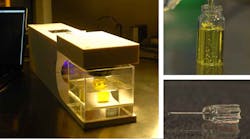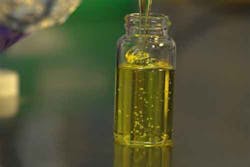Most 3D printers build up 3D objects layer by layer. This creates a “stair-step” effect along the edges. It also limits the printer’s ability to build flexible objects because bendable materials often deform during printing; and stiff supports are required to print objects of certain shapes such as arches and overhangs.
A new printer developed at UC Berkeley relies on a viscous liquid that transforms into a solid when exposed to a certain amount of light. That light is precisely projected as a carefully crafted pattern into a transparent rotating cylinder of the liquid that solidifies into the printed object “all at once.”
The 3D printer works by shining changing patterns of light through a rotating vial of liquid. A computer algorithm calculates the exact patterns of light needed to shape a specific object. (Courtesy: Hayden Taylor)
“Basically, it’s an off-the-shelf video projector I brought from home, and you plug it into a laptop and use it to project a series of computed images, while a motor turns a cylinder that has a 3D printing resin in it,” explains Hayden Taylor, a mechanical engineering professor. “Obviously there are a lot of subtleties to it, including how you formulate the resin and how you compute the light patterns that will be projected, but the barriers to creating a simple version of this tool are not that high.”
Taylor and his used the printer to create a series of objects, from a tiny model of Rodin’s “The Thinker” statue to a customized jawbone model. Currently, they can make objects up to 4 in. in diameter.
The researchers formulated a thick, syrupy liquid that hardens into a solid when exposed to a certain threshold of light. (Courtesy: Stephen McNally)
Besides patterning the light, which requires complex calculations to get the exact shapes and intensities right, the other major challenge was formulating a resin that stays liquid when exposed to a little bit of light but forms a solid when exposed to a lot of light.
“Even liquid you don’t want cured gets exposed to some light, so there needs to be a threshold of light exposure for this transition from liquid to solid,” Taylor says.
UC Berkeley researchers used a new light-based 3D printing technique to add a handle onto a screwdriver shaft. (Courtesy: Stephen McNally)
The resin consists of liquid polymers mixed with photosensitive molecules and dissolved oxygen. Light activates the photosensitive compound which depletes the oxygen. Only in regions where oxygen has been depleted will polymers form the “cross-links” that turn the resin into a solid. Unused resin can be recycled by heating it in an oxygenated atmosphere.
The technique generates almost no material waste and uncured material is 100% reusable—another advantage of support-free 3D printing.
The new printing method can create objects that are smoother, more flexible, and more complex than what is possible with traditional 3D printers. It can also encase objects with new materials. For example, it can add a handle to a metal screwdriver shaft, something current printers struggle to do.
The objects also don’t have to be transparent. Researchers printed objects that appear to be opaque using a dye that transmits light at the curing wavelength but absorbs most other wavelengths.




